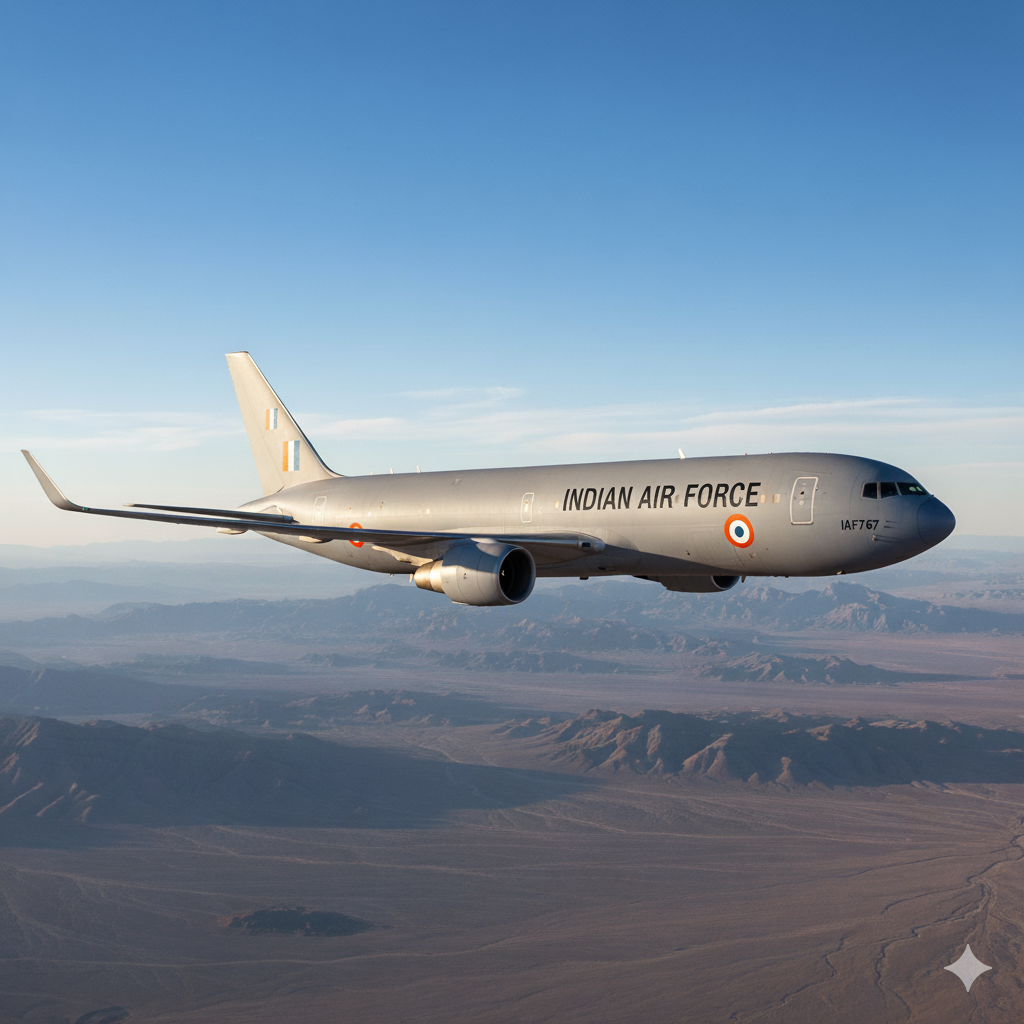IAI Set to Clinch 8000 Crore Deal for 6 Boeing 767 Refuelling Tankers with 30% Make in India
Israel Aerospace Industries is on the verge of securing a single-vendor contract to supply six converted Boeing 767 tanker-transports to the Indian Air Force, marking a major boost to long-range strike capability and indigenous integration.
Deal Overview and Strategic Context
On October 28, 2025, sources within the Ministry of Defence confirmed that Israel Aerospace Industries (IAI) has emerged as the sole qualified bidder for the Indian Air Force’s Mid-Air Refuelling Aircraft program. The contract, valued at approximately 8000 crore rupees, covers the supply of six Boeing 767-300ER platforms converted into multi-role tanker transports (MRTT) with fly-by-wire boom and drogue refuelling systems.
This acquisition addresses a critical operational gap. The IAF currently operates only six aging Ilyushin Il-78MKI tankers, acquired in the early 2000s, which are insufficient for sustained operations across the vast Indo-Pacific theatre. The new 767-based tankers will more than double the fleet’s capacity and enable extended combat radius for Su-30MKI, Rafale, and future Tejas Mk2 squadrons.
Technical Specifications and Capabilities
The IAI-converted 767 MRTT platform offers significant advantages over legacy systems:
- Fuel offload capacity: 65 tonnes (versus 36 tonnes of Il-78)
- Range with maximum fuel: 12,200 km
- Simultaneous refuelling of two fighters via wing pods + one large aircraft via centreline boom
- Cargo/passenger configuration for strategic airlift
- Advanced defensive aids suite including DIRCM and missile approach warning
The aircraft will feature IAI’s latest fly-by-wire boom system, proven on Colombian and Brazilian 767 tankers, with a maximum fuel flow rate of 2,800 litres per minute. Integration of Indian communication systems and IFF transponders will occur during the conversion phase.
Make in India Component: 30% Indigenous Content
A key feature of this deal is the mandated 30% indigenous content, to be achieved through:
| Component | Indian Partner | Scope |
|---|---|---|
| Avionics integration | HAL Hyderabad | Mission computers, displays |
| Cabin interiors | Tata Advanced Systems | Passenger/cargo modules |
| Composite fairings | Mahindra Aerospace | Refuelling pod fairings |
| Ground support equipment | Bharat Electronics | Test benches, simulators |
The conversion work will primarily occur at IAI’s facility in Tel Aviv, but final outfitting and testing of Indian-specific systems will take place at HAL’s Nashik division. This hybrid approach balances operational urgency with technology transfer objectives.
Procurement Process and Timeline
The acquisition follows the Defence Acquisition Procedure 2020 under the “Buy (Global – Make in India)” category. Key milestones include:
- CNC approval: November 2025
- Contract signing: January 2026
- First aircraft delivery: 36 months after contract
- Full operational clearance: 48 months
The single-vendor situation arose after Airbus withdrew its A330 MRTT bid in 2024, citing pricing concerns. IAI’s offer of converted commercial 767s from the secondary market proved more cost-effective, with per-unit pricing approximately 25% lower than new-build A330s.
Operational Impact on IAF Doctrine
The introduction of 767 MRTTs will fundamentally alter IAF operational planning:
- Su-30MKI combat radius extends from 1,500 km to 3,000+ km with one refuelling
- Enables persistent CAP over Andaman & Nicobar Islands
- Supports rapid deployment to Ladakh sector within 4 hours from central India
- Provides strategic airlift backup during HADR operations
The tankers will be based at Panagarh Air Force Station in West Bengal, with forward operating locations at Sulur and Jamnagar. This positioning optimizes coverage for both China and Pakistan fronts while supporting naval operations in the Indian Ocean Region.
Financial and Industrial Implications
Beyond the 8000 crore acquisition cost, the deal includes:
- 10-year performance-based logistics contract
- Training of 60 IAF aircrew and 200 ground personnel
- Establishment of regional MRO facility in India by 2030
- Offset obligations worth 2400 crore in Indian defence industry
The transaction structure involves 60% payment in rupees and 40% in USD, easing foreign exchange pressure. IAI has committed to investing 500 crore in Indian joint ventures as part of offset fulfillment.
Geopolitical Dimensions
This deal strengthens the India-Israel defence partnership, which has grown from $500 million in 2005 to over $2 billion annually. The 767 MRTT selection over European alternatives reflects pragmatic decision-making amid global supply chain disruptions affecting Airbus production.
China’s deployment of Y-20 tankers and Pakistan’s interest in Chinese systems has accelerated India’s procurement timeline. The 767 fleet will provide parity in air-to-air refuelling capability across the region.
Challenges and Risk Mitigation
Potential risks include:
- Dependency on used airframes (average age 18 years)
- Integration complexity with Indian weapon systems
- GE CF6 engine spare parts availability
IAI addresses these through comprehensive structural life extension programs and guaranteed 30-year service life post-conversion. The contract includes penalty clauses for delays beyond 42 months.
Future Expansion Potential
The IAF has identified requirements for three additional tankers by 2035 to support the AMCA program and naval aviation growth. The current contract includes options for two more aircraft at fixed pricing, providing cost certainty for future expansion.
Conclusion
The IAI 767 MRTT deal represents a pragmatic solution to an urgent operational requirement while advancing Make in India objectives. By leveraging commercial platforms with proven military conversions, the IAF achieves capability enhancement without the delays associated with clean-sheet development.
As India positions itself as a net security provider in the Indo-Pacific, force multipliers like aerial refuelling become strategic assets. The 767 tankers will not merely extend aircraft range; they will expand India’s strategic reach and operational flexibility for decades to come.



